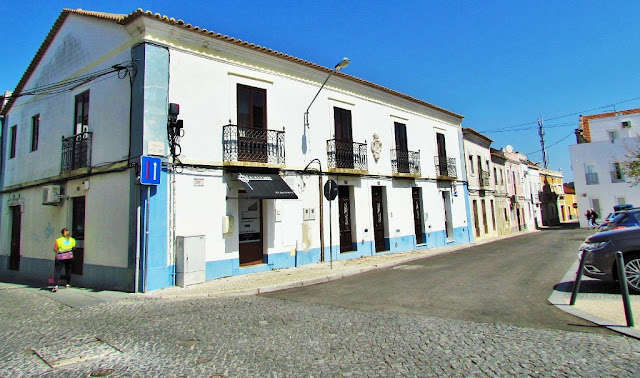GRÂNDOLA
38.17172º N; 8.56347º W
It is the seat of a municipality with an area of 825.94 km² and 14 826 inhabitants (2011), subdivided into 4 parishes (Azinheira dos Barros e São Mamede do Sádão; Carvalhal; Melides; Grândola e Santa Margarida da Serra). The municipality is limited to the north by the municipality of Alcácer do Sal, to the east by Ferreira do Alentejo, to the south by Santiago do Cacém, to the west by the Atlantic Ocean, and to the northwest, through the Sado Estuary, by Setúbal.
Included in this municipality is Tróia (part of Carvalhal parish), a peninsula between the Atlantic Ocean and the Sado River. Also within the municipality is Serra de Grândola (Grândola Mountain). Nearest city: Alcácer do Sal. The coastal portions of the municipality are part of the Comporta region.
The municipal holiday is October 22.
Grândola has its own railway station on the mainline between Lisbon and Faro. Passenger trains are operated by Comboios de Portugal (CP).The Coastal Shore is characterized by its 45 km of white sand beaches and crystal clear waters, the seabed is sandy and vast, as a result of the accumulation of sedimentary materials. Inland, dune systems from Grândola is a Portuguese village in the district of Setúbal, region (NUTS II) of Alentejo and sub-region (NUTS III) of Alentejo Litoral, with about 6 800 inhabitants.
It is the seat of a municipality with an area of 825.94 km² and 14 826 inhabitants (2011), subdivided into 4 parishes. The municipality is limited to the north by the municipality of Alcácer do Sal, to the east by Ferreira do Alentejo, to the south by Santiago do Cacém, to the west by the Atlantic Ocean, and to the northwest, through the Sado Estuary, by Setúbal.
The Coastal Shore is of varying size and typical vegetation that extends into large patches of pine forest. On the coast, the Melides lagoon stands out, and further north, the Sado estuary, with the Carvalhal rice paddies and the muddy banks and the Troia marshes.
Climate
Despite its long coastline, the climate of this municipality can be considered the Mediterranean with Atlantic influence. Due to several factors, it presents both maritime and continental characteristics, with the alternation of Atlantic days and continental characteristics being frequent. The average temperature is around 16.7 ° C.
The rainfall is very irregular throughout the year, the distribution of dry and rainy years is relatively random, and the average annual rainfall is around 600mm.
BEACHES
Discover the largest stretch of beach in the country and the third-largest in the world!If you can't live without a beach, the long coastline of the municipality ensures you great places to discover and, who knows, for a pleasant afternoon of fishing.
Extending from the end of the Troia Peninsula to Melides beach, along 45 km of golden sands, where you can enjoy beaches with high environmental quality. All beaches are awarded the Blue Flag and distinguished as Golden Quality Beach and many are recognized as Accessible Beach for All. Discover them!
😚😚😚😚😚
CASA FRAYÕES METELLO
Building from the first half of the 18th century, located at Rua Vaz Pontes, it is considered one of the most important noble houses in the village of Grândola. Of the stately character, it was the residence of families of the local governance, standing out among its owners Francisco de Paula Frayão Metello, who had the coat of arms given to him in 1780 placed on the facade of the building.
The property was acquired by the City Council in 1867, and different services were installed there throughout the twentieth century, with emphasis on Primary Schools of both sexes, which operated here until 1968.
Since 2004, the Museum and Cultural Heritage Sector of the Municipality of Grândola has been installed in this building, where the exhibitions of the Archaeological History of Grândola - vestiges, and artifacts are patentable to the public; the reconstitution of a primary school classroom; as well as a doctor's office from the 50's, belonging to Dr. Vítor Ribeiro da Rocha and the museum reserves area of the Municipality of Grândola.
The museological reserves are constituted by collections and objects of different types, essentially of an ethnographic nature, which were donated by the inhabitants and/or acquired by the Chamber, refer mainly to the first half of the 20th century and are, almost entirely, related to traditional activities developed in rural and urban environments.
The treatment, inventory, study, and packaging of this and another estate is crucial for its preservation and for the safeguarding of the traditions and memory of the Grandola community.
In addition to this safeguarding work and the organization of exhibitions, the educational service promotes guided visits and regular educational activities of cultural extension on the exhibition themes.
💓💓💓💓💓
SEARCH IN ALPHABETICAL ORDER
IN THE DISTRICT OF SETUBAL
💓💓💓💓💓
Return to mainland Portugal &
the Azores and Madeira islands













































































































































